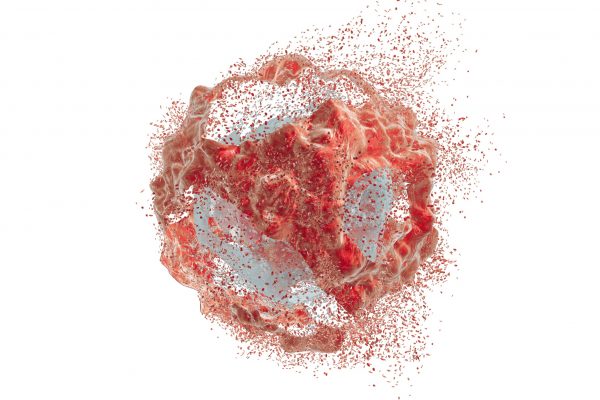
BCL2 inhibition is known to have a synergistic effect with chemotherapy and anti-CD20 monoclonal antibodies for patients with chronic lymphocytic leukaemia (CLL), including patients with chromosome 17p deletions. Investigating the BCL2 inhibitor venetoclax in combination with rituximab in a phase 1b setting, the M13-365 study now reports survival data after 5 years of follow up.
Proteins pertaining to the BCL2 protein family play crucial roles in the regulation of apoptosis and contribute to cancer cell survival and therapy resistance. Venetoclax is a BCL2 inhibitor that has shown promising, single-agent activity, producing an overall response rate of approximately 80% and a complete response (CR) of 6-20% in relapsed/refractory chronic lymphocytic leukaemia (CLL) patients, including those with chromosome 17p deletions, which typically have more aggressive disease. Preclinical studies have identified a synergy between venetoclax and chemotherapy combinations. The combination of rituximab and an earlier BCL2 inhibitor, navitoclax, also proved tolerable and highly active. Consequently, the phase 1b M13-365 study has evaluated the efficacy and safety of venetoclax and rituximab (VenR) with 5 years of follow-up.
49 patients with CLL or small lymphocytic lymphoma with adequate bone marrow, renal and hepatic function were enrolled into 5 dose-escalation cohorts and one expansion cohort. Patients received venetoclax (cohorts 1-2: 50mg; other cohorts: 20mg), escalating to a range of 200mg to 600mg (400mg in the expansion cohort). 1 week after the target dose of venetoclax was achieved, patients received rituximab once a month for 6 months in total (375mg/m2 – 500mg/m2, depending on cohort). Completion of combination therapy was followed by venetoclax monotherapy until unacceptable toxicity, disease progression or drug cessation allowed per protocol. Continuous and limited-duration therapy was also assessed, whereby patients achieving a CR with or without incomplete marrow recovery, or undetectable minimal residual disease were allowed, but not required, to discontinue therapy. Following disease progression, re-treatment with VenR was permitted. After 5 years of follow-up, secondary survival outcomes are presented here, including overall survival (OS), progression-free survival (PFS) and duration of response (DoR).
At a median follow-up of 5.3 years, the OS rate was found to be 86% (95%CI: 72%-94%). 5-year PFS and DoR was also encouraging, at 56% (95%CI: 40-70%) and 58% (95%CI: 40-73), respectively. 33 patients achieved a deep response, defined as either a CR with or without incomplete marrow recovery or undetectable minimal residual disease. At data cut-off, 14 of these deep responders remained on venetoclax monotherapy. 19 patients stopped venetoclax therapy after a median duration of 1.4 years. 5-year of ongoing response were comparable between continuous and limited-duration therapy, respectively (71% [95%CI: 39% – 88%] vs. 79% [95%CI: 49% – 93%]), indicating that a limited-duration dosing schedule may not be inferior to a continuous protocol at 5 years. However, 6 of these 19 patients did experience disease progression. All cases occurred >2 years off venetoclax. 4 of these patients were subsequently re-treated with VenR, and a partial response was observed in 3 evaluable patients.
At 5 years of follow-up, VenR was able to induce highly durable, deep responses with both continuous and limited-duration therapy scheduling. Furthermore, retreatment with VenR induced partial responses in patients who experienced disease progression. Finally, continuous exposure to venetoclax does not appear to provide an incremental benefit, although these results require validation in a larger cohort study.
Reference